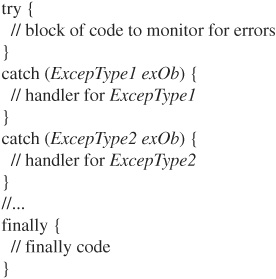Using finally
Sometimes you will want to define a block of code that will execute when a try/catch block is left. For example, an exception might cause an error that terminates the current method, causing its premature return. However, that method may have opened a file or a network connection that needs to be closed. Such types of circumstances are common in programming, and Java provides a convenient way to handle them: finally.
To specify a block of code to execute when a try/catch block is exited, include a finally block at the end of a try/catch sequence. The general form of a try/catch that includes finally is shown here.

The finally block ...
Get Java, A Beginner's Guide, 5th Edition, 5th Edition now with the O’Reilly learning platform.
O’Reilly members experience books, live events, courses curated by job role, and more from O’Reilly and nearly 200 top publishers.

